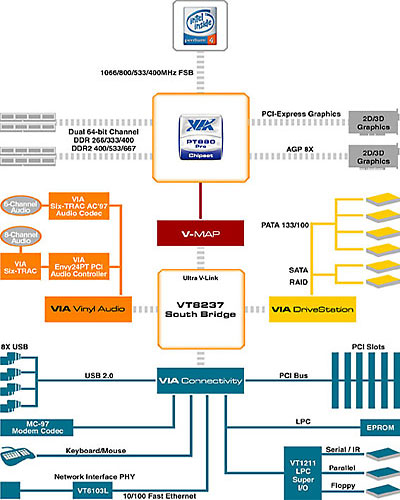VIA's PT880 Pro

PT880 Pro is somewhat of an enigma. In essence, it augments all support for all LGA775 processors, DDR-II and PCI Express to their existing PT880 product, launched over a year ago. That base product gave you an AGP8X interface and DDR400 memory support for Pentium 4, paired with their VT8237 I/O bridge at the time.
So PT880 Pro's list of features looks very impressive. Let me lay it out in a table for you.
| VIA's PT880 Pro Core Logic | |
| CPU Support | All Intel Pentium 4 LGA775 Processors |
| Northbridge | VIA PT880 Pro |
| Memory Support | Dual-channel, up to DDR400 or DDR2-667 |
| AGP | Support for one slot, 8X, 1.5V |
| PEG16X | Support for one slot, 16X, 0.8V |
| Southbridge | VIA's VT8237 or possible VT8251 |
| Audio | VIA Vinyl Audio supporting discrete ASIC and AC'97 interfaces |
| PCI | 6 x 32-bit 33MHz PCI 2.1 slot controller (7 slots with VT8251) |
| PCI Express | 20 lanes in total on the northbridge (16 exposed), 2 lanes on possible VT8251 |
| IDE | VIA's DriveStation giving 4 drive support up to ATA133 |
| IDE RAID | Possible 0, 1, 0+1 and JBOD depending on I/O processor |
| SATA | 2 devices from VT8237, 4 devices with command queueing from VT8251 |
| SATA RAID | Possible 0, 1, 0+1 and JBOD depending on I/O processor |
| Networking | 100Mbit Ethernet MAC on both I/O processors, GigE support on VT8251 |
| USB | 8 ports on both I/O processors |
| FireWire | None |
| Other I/O | MC'97, LPC, PS/2, Ultra V-Link |
Taking a closer look, starting from the top of the table, support for all LGA775 processors means that PT880 Pro brings support for a 266MHz base clock for the CPU-to-memory interface (front side bus). With four data samples per clock (quad-pumped) that means 1066MHz bus support for the current range of Extreme Edition processors on LGA775 is there.
Then you've got VIA's Universal Graphics interface on the bridge. That's a full, native AGP8X controller and a native PEG16X host interface on the same bridge. No link of two PCI slots at dual speed without the DIME controller, but a full AGP implementation. I'll talk about that in more detail in due course.
The FastStream memory controller in PT880 Pro supports both DDR and DDR-II memory and in its DDR2 implementation it fully supports low-latency DDR2 at 667MHz, for support for the very fastest DDR2 modules on the market today.
VIA are somewhat cripping the PT880 Pro by effectively mandating that it's paired with VT8237 or VT8237R at the moment, which are fine southbridge I/O processors in their own right, but VT8251 brings more PCI Express to the table and native support for 4-drive SATA with command queueing.
VIA's Vinyl Audio is fully supported, as you'd expect and everything that makes a good VIA core logic product is present and correct. Ultra V-Link is a fine interconnect, while VMAP makes it easy to drop in support for new designs for quick time to market and reduced cost.
VIA's Universal Graphics
The inclusion of a full AGP8X host and a full PEG16X root host for graphics connectivity is the big deal for PT880 Pro. All PT880 Pro boards will carry both slots and you're able to populate both slots at the same time and have full support, including 3D acceleration, on both devices at the same time in a modern operating system like Windows XP. That's a significant slice of technology for the market that PT880 Pro is aimed at.Upgrader's heaven
It's a somewhat low-cost upgraders platform for Pentium 4. You've got Socket 478, DDR400 and AGP8X at the moment and you want to move to Intel's new platform in due course, but can't make it all at once. PT880 Pro lets you make the investment in the new LGA775 processor as your first step as you take your existing memory and graphics card with you.Then you can upgrade graphics and memory piecewise, as and when you choose. That's extremely important, should the chipset work and hold up its end of the bargain in terms of performance.
That you can run both graphics cards at the same time opens doors for quad head computing with four monitors on one PC. I run dual monitors day in, day out, and I can tell you that four heads is something I'd love to run. Adding more and more screen space is a good thing for many groups of people. VIA recommend you use graphics cards from the same base IHV - so a pair of NVIDIA boards or a pair of ATI boards - but it can and will work with mixed vendor hardware. More on that soon.
PT894 follows.









